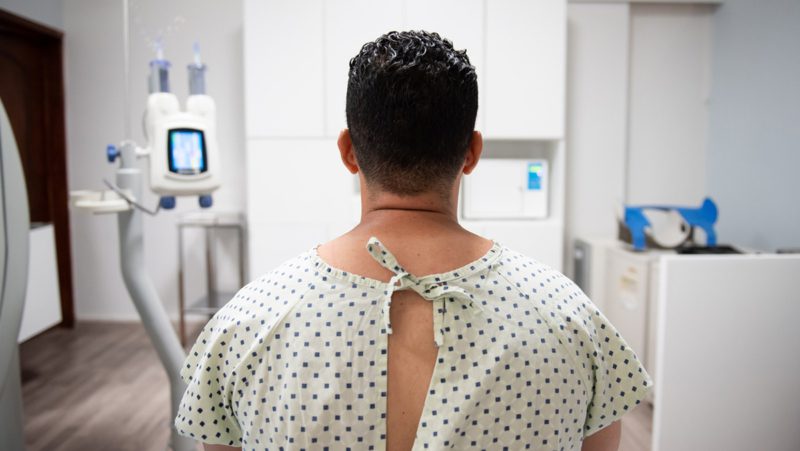The research, led by the Keck School of Medicine of USC, analyzed risk for the disease across more than 30,000 Mexican Americans, finding third-generation Mexican Americans 66% more likely to get liver cancer than the first generation.
By Zara Abrams
In the United States, liver cancer rates have more than tripled since 1980. Some groups, including Latinos, face an even higher risk than the general population—but researchers do not fully understand why.
A study from the Keck School of Medicine of USC, funded by the National Cancer Institute, has shed new light on those disparities. Researchers found that among Mexican Americans, liver cancer risk rises the longer a person’s family has lived in the U.S. That increased risk primarily affected men. The findings were just published in the journal Cancer.
“With each successive generation, we’re seeing an increased risk of liver cancer. When we look more closely at this trend, the numbers are significant,” said lead author Veronica Wendy Setiawan, PhD, a professor of population and public health sciences and the Jane and Kris Popovich Chair in Cancer Research at the Keck School of Medicine.
Setiawan and her colleagues analyzed data on first-, second- and third-generation Mexican Americans. Compared to the first generation, second-generation Mexican Americans were 37% more likely to develop liver cancer and third-generation Mexican Americans were 66% more likely to get the disease.
Metabolic syndrome (which includes obesity and diabetes) and lifestyle factors, such as an increase in alcohol consumption and smoking in later generations, can explain some—but not all—of the increased risk. More research is needed to understand what other factors are linked to the rise in liver cancer cases.
“The Mexican American population is growing, but there’s so little research that focuses on this group,” said Setiawan, who is also co-leader of the Cancer Epidemiology Program at the USC Norris Comprehensive Cancer Center. “So, there’s a lot that we still don’t know.”
Unexplained disparities
The researchers studied 31,377 Mexican Americans who were part of the Multiethnic Cohort Study, a collaboration between USC and the University of Hawaii Cancer Center. First-generation participants were born in Mexico; second-generation participants were born in the U.S. with one or both parents born in Mexico; and third-generation participants were born in the U.S. along with both of their parents.
Across all generations, 213 participants developed liver cancer. Compared to the first generation, second- and third-generation Mexican Americans faced a 37% and 66% increased risk, respectively. Researchers believe the increased risk may primarily affect men because they tend to have more risk factors related to disease than women.
The researchers controlled for a number of factors that could influence a person’s risk of developing liver cancer, including higher rates of alcohol and cigarette use, as well as higher average body mass index. They also accounted for neighborhood-level factors that can influence cancer risk, including socioeconomic status and living in an “ethnic enclave,” a geographic area with many residents of a single ethnicity.
“After we adjust for those factors that are different across generations, we still see these higher risks,” Setiawan said. “That tells us that this is an important population to study further.”
An ongoing search for answers
Further research on lifestyle and neighborhood factors, including data on diet, education and environmental exposures, can help researchers continue to explain the ethnic disparities in liver cancer risk. That knowledge can ultimately support targeted prevention efforts to protect high-risk populations from developing the disease, Setiawan said.
She and her colleagues have also received funding from the National Institutes of Health to recruit approximately 2,000 Latino participants across Los Angeles Country with fatty liver disease, one potential precursor of liver cancer. They will perform ultrasound scans to track liver health over time and collect detailed information about diet and other aspects of health to get a clearer picture of how the disease progresses.
About this research
In addition to Setiawan, the study’s other authors are Nicholas Acuna and Christopher A. Haiman from the Department of Population and Public Health Sciences, Keck School of Medicine of USC; Kali Zhou from the Division of Gastrointestinal and Liver Diseases, Keck School of Medicine of USC; Tiffany Lim from the Center for Genetic Epidemiology, Keck School of Medicine of USC; Paulo S. Pinheiro from the Sylvester Comprehensive Cancer Center and the Department of Public Health Sciences, University of Miami School of Medicine; Iona Cheng and Salma Shariff-Marco from the Hellen Diller Family Comprehensive Cancer Center and the Department of Epidemiology and Biostatistics, University of California, San Francisco; and Lynn R. Wilkens and Loïc Le Marchand from the Epidemiology Program, University of Hawaii Cancer Center.
This work is supported by the National Cancer Institute [U01CA164973, R01CA228589, R01CA154644].
